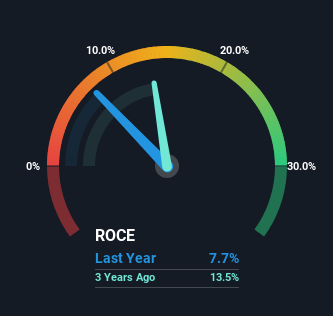- Hong Kong
- /
- Trade Distributors
- /
- SEHK:1545
Design Capital (HKG:1545) May Have Issues Allocating Its Capital

If we want to find a potential multi-bagger, often there are underlying trends that can provide clues. Firstly, we'd want to identify a growing return on capital employed (ROCE) and then alongside that, an ever-increasing base of capital employed. This shows us that it's a compounding machine, able to continually reinvest its earnings back into the business and generate higher returns. However, after briefly looking over the numbers, we don't think Design Capital (HKG:1545) has the makings of a multi-bagger going forward, but let's have a look at why that may be.
Return On Capital Employed (ROCE): What Is It?
Just to clarify if you're unsure, ROCE is a metric for evaluating how much pre-tax income (in percentage terms) a company earns on the capital invested in its business. The formula for this calculation on Design Capital is:
Return on Capital Employed = Earnings Before Interest and Tax (EBIT) ÷ (Total Assets - Current Liabilities)
0.077 = S$5.1m ÷ (S$91m - S$24m) (Based on the trailing twelve months to June 2023).
Thus, Design Capital has an ROCE of 7.7%. On its own that's a low return, but compared to the average of 5.0% generated by the Trade Distributors industry, it's much better.
View our latest analysis for Design Capital

Historical performance is a great place to start when researching a stock so above you can see the gauge for Design Capital's ROCE against it's prior returns. If you want to delve into the historical earnings, revenue and cash flow of Design Capital, check out these free graphs here.
What The Trend Of ROCE Can Tell Us
On the surface, the trend of ROCE at Design Capital doesn't inspire confidence. Over the last five years, returns on capital have decreased to 7.7% from 41% five years ago. Although, given both revenue and the amount of assets employed in the business have increased, it could suggest the company is investing in growth, and the extra capital has led to a short-term reduction in ROCE. If these investments prove successful, this can bode very well for long term stock performance.
On a side note, Design Capital has done well to pay down its current liabilities to 26% of total assets. That could partly explain why the ROCE has dropped. Effectively this means their suppliers or short-term creditors are funding less of the business, which reduces some elements of risk. Some would claim this reduces the business' efficiency at generating ROCE since it is now funding more of the operations with its own money.
What We Can Learn From Design Capital's ROCE
Even though returns on capital have fallen in the short term, we find it promising that revenue and capital employed have both increased for Design Capital. However, total returns to shareholders over the last three years have been flat, which could indicate these growth trends potentially aren't accounted for yet by investors. So we think it'd be worthwhile to look further into this stock given the trends look encouraging.
On a final note, we found 3 warning signs for Design Capital (1 is a bit concerning) you should be aware of.
For those who like to invest in solid companies, check out this free list of companies with solid balance sheets and high returns on equity.
New: Manage All Your Stock Portfolios in One Place
We've created the ultimate portfolio companion for stock investors, and it's free.
• Connect an unlimited number of Portfolios and see your total in one currency
• Be alerted to new Warning Signs or Risks via email or mobile
• Track the Fair Value of your stocks
Have feedback on this article? Concerned about the content? Get in touch with us directly. Alternatively, email editorial-team (at) simplywallst.com.
This article by Simply Wall St is general in nature. We provide commentary based on historical data and analyst forecasts only using an unbiased methodology and our articles are not intended to be financial advice. It does not constitute a recommendation to buy or sell any stock, and does not take account of your objectives, or your financial situation. We aim to bring you long-term focused analysis driven by fundamental data. Note that our analysis may not factor in the latest price-sensitive company announcements or qualitative material. Simply Wall St has no position in any stocks mentioned.
About SEHK:1545
Design Capital
An investment holding company, engages in furniture business in Singapore, the United States, and Malaysia.
Flawless balance sheet low.
Similar Companies
Market Insights
Community Narratives



